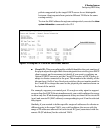
IP Routing Features
Configuring DHCP Relay
Secondary Relay Agent: In the path between a DHCP client and a DHCP
server, any routing switch (configured to support DHCP operation) other than
the primary relay agent.
General DHCP Option 82 Requirements and Operation
Requirements. DHCP Option 82 operation is configured at the global config
level and requires the following:
■ IP routing enabled on the switch
■ DHCP-Relay Option 82 enabled (global command level)
■ routing switch access to an Option 82 DHCP server on a different subnet
than the clients requesting DHCP Option 82 support
■ one IP Helper address configured on each VLAN supporting DHCP clients
General DHCP-Relay Operation with Option 82. Typically, the first
(primary) Option 82 relay agent to receive a client’s DHCP request packet
appends an Option 82 field to the packet and forwards it toward the DHCP
server identified by the IP Helper address configured on the VLAN in which
the client packet was received. Other, upstream relay agents used to forward
the packet may append their own Option 82 fields, replace the Option 82
field(s) they find in the packet, forward the packet without adding another
field, or drop the packet. (Intermediate next-hop routing switches without
Option 82 capability can be used to forward—route—client request packets
with Option 82 fields.) Response packets from an Option 82 server are routed
back to the primary relay agent (routing switch), and include an IP addressing
assignment for the requesting client and an exact copy of the Option 82 data
the server received with the client request. The relay agent strips off the Option
82 data and forwards the response packet out the port indicated in the
response as the Circuit ID (client access port). Under certain validation
conditions described later in this section, a relay agent detecting invalid
Option 82 data in a response packet may drop the packet.
3-51


















